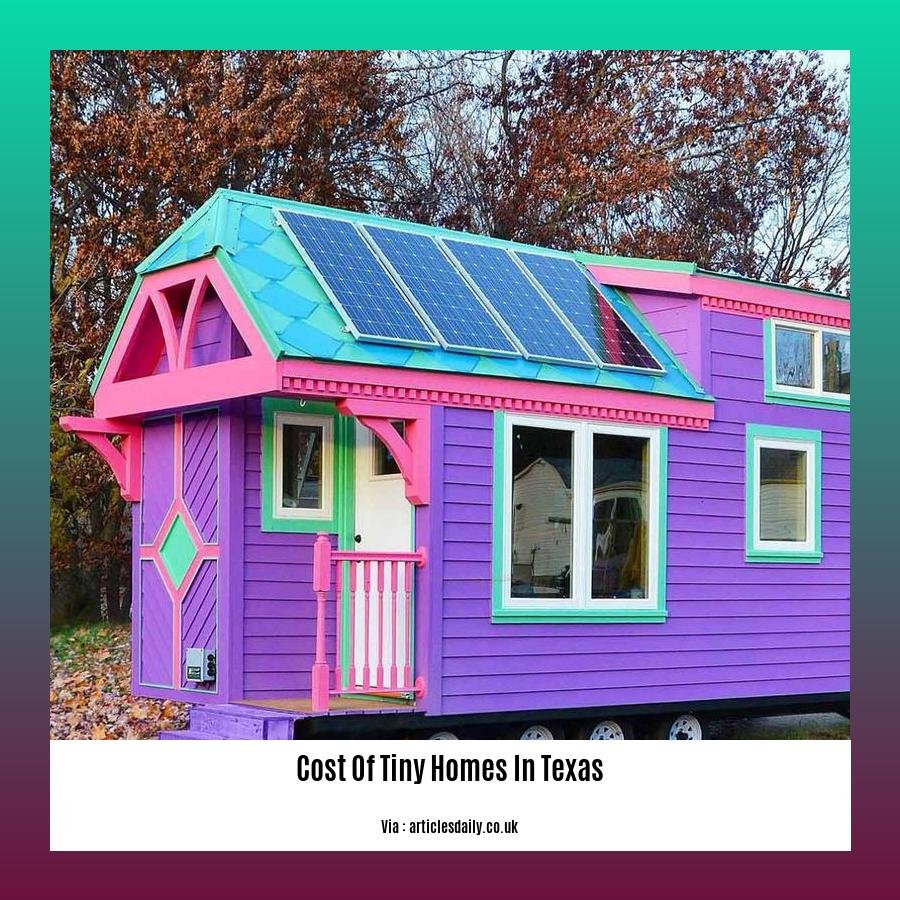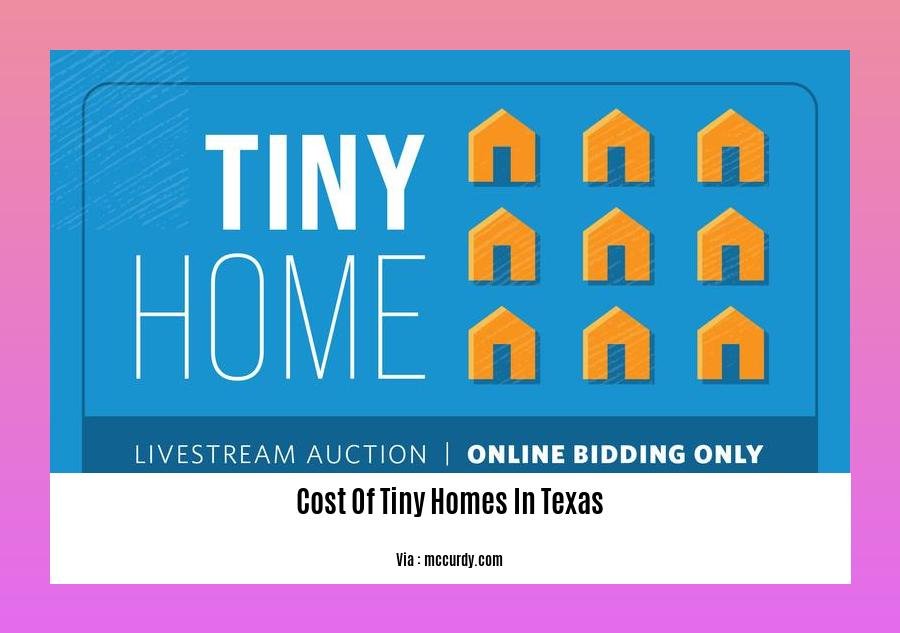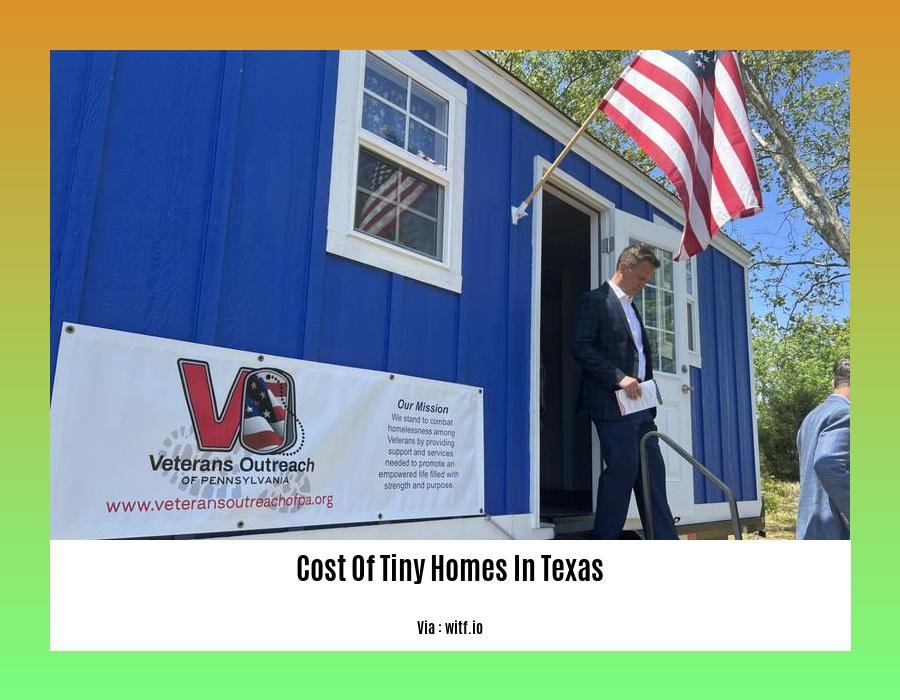The Rising Cost of Tiny Homes in Texas: A Comparative Analysis
Tiny homes have gained popularity in Texas in recent years as an affordable and eco-friendly housing option. However, the cost of tiny homes in Texas has been rising steadily, making it important for potential buyers to understand the factors driving this trend. This article provides a comparative analysis of the rising cost of tiny homes in Texas, examining the market data, expert insights, and practical tips for navigating this unique housing segment.
Key Takeaways:
-
The cost of tiny homes in Texas generally ranges from $30,000 to $60,000, depending on size and design.
-
Tiny homes provide an affordable and sustainable living alternative, particularly for those seeking a minimalist lifestyle and cost-sensitive individuals.
-
They are prefabricated in factories and later assembled on-site, with an average cost ranging from $40,000 to $50,000.
-
Tiny homes are favorable due to their affordability, sustainability, and inherent mobility, which allows for flexible living arrangements.
Cost of Tiny Homes in Texas

The Lone Star State offers an array of housing options, and tiny homes are gaining traction as a cost-effective and sustainable living solution. This guide delves into the factors that influence the cost of tiny homes in texas, helping you make informed decisions if you’re considering this unique lifestyle.
Factors Affecting the Cost
-
Size: The square footage is a primary determinant of cost. Generally, the larger the tiny home, the higher the price.
-
Materials: The choice of building materials significantly impacts the cost. Opting for sustainable materials like recycled steel or reclaimed wood can increase the price.
-
Design Complexity: A simple and efficient design is more cost-effective than an intricate one with numerous features and customizations.
-
Customization: Personalizing your tiny home with unique features like custom cabinetry, high-end appliances, or a loft bedroom will raise the cost.
-
Location: The cost of land and labor varies across Texas, so the location of your tiny home can affect the overall price.
Cost Breakdown
Tiny homes are typically more affordable than traditional houses, but the exact cost depends on the factors mentioned above. Here’s a rough breakdown of the typical costs associated with tiny homes:
- Materials: $10,000 – $25,000
- Labor: $5,000 – $15,000
- Appliances: $3,000 – $5,000
- Installation: $2,000 – $5,000
- Permits and Fees: $1,000 – $3,000
Cost-Effective Designs
Affordability doesn’t mean sacrificing comfort. Here are some tips for designing a cost-effective tiny home:
-
Prioritize Functionality: Focus on creating a functional living space rather than adding unnecessary features.
-
Choose Multi-Purpose Furniture: Invest in furniture that serves multiple purposes, like a sofa bed or a coffee table with hidden storage.
-
DIY Projects: If you’re handy, take on DIY projects to save money on labor costs.
-
Shop Smart: Compare prices from different suppliers and consider buying used or refurbished materials.
DIY vs. Professional Construction
Building a tiny home yourself can save you money, but it requires skills, time, and patience. If you lack the expertise, hiring a professional builder is a safer option.
Financing Options
There are various financing options available for tiny homes, including:
-
Tiny Home Loans: Some banks and credit unions offer loans specifically for tiny homes.
-
Personal Loans: You can use a personal loan to cover the cost of your tiny home, but interest rates may be higher.
-
Grants: Certain government programs and non-profit organizations offer grants to help individuals purchase or build tiny homes.
Long-Term Cost Considerations
Beyond the initial cost, consider ongoing expenses associated with owning a tiny home:
-
Maintenance: Regular maintenance is crucial to keep your tiny home in good condition.
-
Utilities: Tiny homes generally have lower utility bills compared to traditional houses.
-
Property Taxes: You’ll likely pay property taxes on your tiny home, even if it’s on wheels.
-
Insurance: Tiny homes can be insured just like traditional homes.
So, are tiny homes worth the cost in Texas? If you’re looking for an affordable, sustainable, and unique living option, a tiny home may be the perfect choice for you. Just be prepared for the upfront and ongoing costs associated with owning one.
Thinking of creating your dream home in Ontario? Discover the cost of prefab homes in Ontario and make informed decisions about your future home.
Are you considering a prefab home in the UK? Find out the cost of prefab homes in the UK and explore your options for sustainable and affordable living.
Planning for your retirement in Ottawa? Learn about the cost of retirement homes in Ottawa and secure a comfortable and enjoyable retirement lifestyle.
Cost-Effective Tiny Home Designs in Texas

Key Takeaways:
- Affordability: Tiny homes offer a more cost-effective housing option compared to traditional homes. The cost of building a tiny home in Texas ranges from $20,000 to $100,000, with an average between $50,000 and $75,000.
- Factors Affecting Cost: Factors like size, materials, design, customizations, and location significantly influence the overall cost.
- Cost-Effective Designs: Prioritizing functionality, choosing multi-purpose furniture, opting for DIY projects, and shopping smartly for materials can help reduce costs.
- DIY vs. Professional Construction: Weigh the cost savings of DIY against the time and skills required. Hiring a professional builder might be a safer option.
- Financing Options: Tiny home loans, personal loans, and government grants are available financing options.
- Long-Term Cost Considerations: Regular maintenance, lower utility bills, potential property taxes, and insurance costs should be considered.
Factors That Influence the Cost of Tiny Homes:
- Size: Larger tiny homes typically have higher costs associated with materials, labor, and overall construction.
- Materials: Sustainable materials are more expensive than traditional ones, but they offer better durability and energy efficiency in the long run.
- Design: Intricate designs and complex layouts increase the overall cost of building a tiny home.
- Customization: Unique features and custom-built elements add to the total cost of the tiny home.
- Location: The cost of land, labor, and materials can vary depending on the specific location in Texas.
Creating a Cost-Effective Tiny Home:
- Prioritize Functionality: Focus on designing a space that efficiently meets your needs and lifestyle, avoiding unnecessary features or overly complex layouts.
- Multipurpose Furniture: Choose furniture pieces that serve multiple purposes, such as a sofa bed or a dining table that doubles as a workspace.
- DIY Projects: If you have the skills and time, take on DIY projects to save money on labor costs.
- Shop Smart for Materials: Look for discounted materials, compare prices from different suppliers, and consider using reclaimed or recycled materials.
DIY vs. Professional Construction:
Building a tiny home yourself can save money, but it requires construction skills, time, and the right tools. Hiring a professional builder ensures quality construction and adherence to building codes, but it comes with additional costs.
Financing Options for Tiny Homes:
- Tiny Home Loans: These specialized loans are designed specifically for financing tiny homes and often have competitive interest rates.
- Personal Loans: Personal loans can be used to finance a tiny home, but they may have higher interest rates compared to tiny home loans.
- Government Grants: Some government programs and non-profit organizations offer grants to help individuals build or purchase tiny homes.
Long-Term Cost Considerations:
- Maintenance: Regular maintenance is crucial for the longevity of your tiny home. Budget for routine inspections and repairs.
- Utilities: Tiny homes often have lower utility bills due to their compact size and energy-efficient designs.
- Property Taxes: If your tiny home is placed on a permanent foundation, it may be subject to property taxes. Check local regulations for specific details.
- Insurance: Tiny homes can be insured just like traditional homes. Shop around for the best insurance rates.
1. “Cost of Tiny Homes in Texas” – Tiny House Texas
2. “How Much Does it Cost to Build a Tiny House?” – The Tiny Life
DIY vs. Professional Construction of Tiny Homes in Texas
Key Takeaways:
- Both DIY and professional construction methods have distinct advantages.
- DIY is more cost-effective but requires experience, while professional construction offers convenience but can be pricey.
- Research and planning are crucial for both approaches to achieve desired outcomes.
- Local regulations, material costs, and labor rates play a role in budgeting.
Tiny homes are gaining popularity due to their affordability and mobility. But the decision between building one yourself or hiring a professional builder can be a conundrum.
Let’s weigh the pros and cons of each approach.
DIY Tiny Home Construction:
Pros:
- Affordability: DIY construction can save you a significant chunk of money compared to hiring a professional.
- Customization: You have full control over the design, layout, and materials, allowing for a truly personalized living space.
- Learn a New Skill: Building a tiny home can be a rewarding experience, offering hands-on knowledge and satisfaction.
Cons:
- Time Commitment: Building a tiny home DIY can take several months, requiring significant time and effort,
- Skill Requirement: DIY construction requires a good grasp of carpentry, plumbing, and electrical work.
- Liability: You bear all responsibility for the quality and safety of your construction, increasing the potential for mistakes.
Professional Tiny Home Construction:
Pros:
- Convenience: Hiring a professional eliminates the burden of planning, building, and permits.
- Expertise: Professionals have the skills and experience to ensure a high-quality, sturdy construction.
- Warranty: Many builders provide warranties for their work, offering peace of mind.
Cons:
- Cost: Hiring a professional builder is generally more expensive than DIY construction.
- Design Limitations: You may have less control over the design and customization of your tiny home.
- Communication Challenges: Ensuring your ideas and preferences are aligned with the builder’s can be a challenge.
Ultimately, the choice depends on your budget, time constraints, building skills, and personal preferences. Research local regulations, material costs, and labor rates to make a well-informed decision.
Citation:
Tiny Homes Cost in Texas: No.1 Buying Guide
How Much Does It Cost to Build a Tiny House in Texas?
Financing Options and Long-Term Cost Considerations for Tiny Homes in Texas
Howdy, folks! Let’s dive into the nitty-gritty of tiny home costs in the Lone Star State. I’ve got some insights to share on the total picture, from financing options to long-term considerations.
Key Takeaways:
- Affordability: Tiny homes offer a more budget-friendly alternative to traditional housing, making them an attractive choice for value seekers.
- Financing Options: Special loans and grants tailored to tiny homes can help secure funding, but lenders may require additional documentation due to the unique nature of these dwellings.
- Long-Term Costs: While tiny homes tend to have lower utility bills, ongoing maintenance and potential depreciation can offset initial savings.
Financing Options:
- Tiny Home Loans:
- Specifically designed for tiny homes, these loans often come with competitive interest rates.
-
Documentation such as proof of land ownership and construction plans may be required.
-
Personal Loans:
- Can be used for various purposes, including tiny home financing.
-
Interest rates may be higher compared to tiny home loans.
-
Government Grants:
- Certain government programs offer grants for energy-efficient or sustainable tiny homes.
-
Research available grants to determine eligibility.
-
Crowdfunding:
- Online platforms allow individuals to contribute funds to tiny home projects.
- Can be a creative way to raise capital, but success depends on effective marketing and promotion.
Long-Term Cost Considerations:
- Maintenance:
- Regular upkeep and maintenance are essential to ensure the longevity of your tiny home.
-
Consider factors such as weather conditions and material durability when planning maintenance.
-
Utilities:
- Utility bills in tiny homes are typically lower due to their compact size and energy-efficient designs.
-
However, costs can vary depending on the specific features and appliances used.
-
Property Taxes:
- Tiny homes on wheels may still be subject to property taxes, depending on local regulations.
-
Research local tax laws to determine your obligations.
-
Insurance:
- Tiny homes can be insured like traditional homes, providing protection against damages or liability.
-
Shop around for quotes from multiple insurance providers to find the best coverage at a competitive price.
-
Depreciation:
- Unlike traditional homes, tiny homes may depreciate over time, affecting their resale value.
- Consider this factor when making long-term financial decisions.
In the vast landscape of Texas, tiny homes are gaining popularity as a cost-effective and sustainable housing option. Carefully assessing the financing options and long-term costs is crucial to making an informed decision. Remember, there’s no one-size-fits-all solution; the best choice depends on your unique circumstances and financial goals.
Citation:
[1] Cost of Owning a Tiny House: A Comprehensive Guide
[2] Financing a Tiny House: A Step-by-Step Guide
FAQ
Q1: How much does a tiny home in Texas cost?
A1: The cost of a tiny home in Texas can vary depending on size, design, and features. On average, tiny homes range from $30,000 to $60,000, with the average cost being around $40,000 to $50,000.
Q2: What are the advantages of living in a tiny home in Texas?
A2: Tiny homes in Texas offer several advantages, including affordability, sustainability, mobility, and a simpler lifestyle. They are also becoming increasingly popular due to their low maintenance requirements and the growing demand for alternative housing options.
Q3: What factors influence the cost of a tiny home in Texas?
A3: Several factors can influence the cost of a tiny home, including size, design, materials used, and the level of customization desired. Additionally, the cost of land and labor can also impact the overall price.
Q4: Are there any financing options available for tiny homes in Texas?
A4: Yes, there are various financing options available for tiny homes in Texas. Some lenders offer personal loans specifically designed for tiny home purchases, and other options include home equity loans, FHA loans, and VA loans.
Q5: What are some of the challenges associated with living in a tiny home in Texas?
A5: Living in a tiny home can come with certain challenges, such as limited space, zoning regulations, and the need for specialized insurance. Additionally, finding suitable land for a tiny home can be challenging, and there may be restrictions on where tiny homes can be placed.
- The Best Battery Picture Lamps for Effortless Artwork Illumination - April 1, 2025
- Double Sink Bath Vanity Tops: A Buyer’s Guide - April 1, 2025
- Bath Towel Measurements: A Complete Guide to Choosing the Right Size - April 1, 2025










